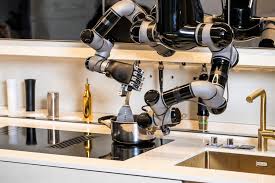Moley Robotics is bringing cutting-edge automation to high-end kitchens with its impressive, yet extravagant, robotic cooking system. Located in a sleek showroom on London’s prestigious Wigmore Street—a destination known for its ultra-luxurious offerings—Moley Robotics presents a kitchen experience that combines a state-of-the-art robot arm with a modern, minimalist design.
At the heart of the display is the X-AiR, a one-armed robot designed to handle the cooking process from start to finish. Initially, Moley showcased a more complex, two-armed version that ran along overhead tracks, but due to its prohibitive cost (over £250,000 or roughly $330,000), the company opted for a simplified single-arm model, sourced from Universal Robots. This move brings the price down to about £80,000 (around $105,000), though buyers must also invest in a new countertop, custom shelving, a cooktop, and a control tablet to complete the system.
The concept behind Moley’s innovation is to promote healthier eating by reducing reliance on processed foods. The idea emerged from Dr. Mark Oleynik’s dissatisfaction with reheated and mass-produced meals. Instead, his solution is a system that prepares fresh ingredients with minimal human intervention. The process begins with a human chef—James Taylor—who adapts recipes so that the robot can reproduce them reliably. By observing a chef’s movements, the robot learns each step, promising a level of precision that aims to exceed that of human error.
In a live demonstration using an Asian Tofu Saute recipe developed with input from the SHA Wellness Clinic, pre-prepared ingredients are arranged in designated positions. Users simply confirm which ingredients are where via an interactive diagram, and then the robot takes over. Although the arm operates purely from memory—without any advanced vision or sensing capabilities—it manages to execute tasks like pouring oil, stirring, and adding ingredients in a methodical sequence. Some minor issues were noted, such as small remnants of ingredients occasionally sticking to the spatula, but these are attributed to the limitations of its non-sensing design.
Despite the novelty and occasional quirks, the end result was a plate of tofu that, contrary to the author’s personal reservations about the dish, was both pleasantly textured and flavorful. The system, however, is currently limited in its capacity, producing meals that serve roughly eight to ten portions—suitable for intimate gatherings rather than large-scale catering.
Looking ahead, Oleynik envisions these robotic chefs catering to a variety of markets. The primary target is the affluent yet time-pressed individual, for whom a private chef’s services are prohibitively expensive. Future applications could include high-end airline meals, automated hotel room service, or even culinary services in care homes and remote service stations. Despite the high upfront costs and the continued need for human intervention in ingredient preparation and serving, the company projects that businesses could see a return on their investment within the first year.
Moreover, as the technology matures, Oleynik expects the overall price to drop further. He hints at a future where a fully automated cooking system might be available for as little as £10,000—making luxury automation more accessible, albeit still within the realm of high-end kitchens.
In summary, while Moley Robotics’ current offering is firmly aimed at the wealthy, its innovative approach to automating the cooking process represents a bold step toward rethinking how we prepare and consume fresh, quality meals.

 Email Us
Email Us


